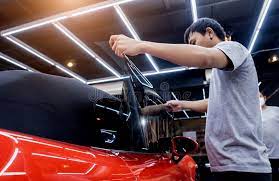Window tinting is more than just a fashion statement solar control window tinting for your car or home—it’s a blend of art and science that offers numerous practical benefits. From enhancing privacy to boosting energy efficiency, window tinting has evolved into a sophisticated technology with a variety of applications.
Aesthetic Appeal Meets Functionality
At its core, window tinting can significantly improve the appearance of a vehicle or building. Available in various shades and finishes, tinted windows can lend a sleek, modern look to any surface. However, the benefits extend far beyond aesthetics.
Enhanced Privacy and Security
One of the most immediate advantages of window tinting is the increased privacy it offers. Tinted windows obscure the view from the outside, making it harder for prying eyes to see inside. This can be especially valuable for homeowners who want to maintain their privacy or for businesses that wish to protect sensitive information. Additionally, the added layer of film can provide an extra level of security by holding shattered glass together in the event of a breakage.
UV Protection and Health Benefits
Window tinting serves as a shield against harmful ultraviolet (UV) rays. Prolonged exposure to UV rays can lead to skin damage and increase the risk of skin cancer. High-quality window tints can block up to 99% of UV radiation, protecting both the occupants and the interior furnishings from sun-induced wear and tear.
Energy Efficiency and Cost Savings
Another significant advantage of window tinting is its impact on energy efficiency. Tinted windows can help regulate indoor temperatures by blocking out heat in the summer and retaining warmth during the winter. This can reduce the reliance on air conditioning and heating systems, leading to noticeable savings on energy bills. In fact, some studies suggest that window tinting can cut cooling costs by up to 30%.
Glare Reduction for Better Visibility
Glare from the sun can be a major distraction while driving or working, leading to eye strain and potential accidents. Window tinting reduces glare, enhancing visibility and comfort. This is particularly beneficial for drivers who often travel in bright, sunny conditions or for office workers who need to minimize eye fatigue.
Types of Window Tinting Films
There are several types of window tinting films, each offering different benefits:
- Dyed Films: These are the most common and affordable type of tint. They reduce glare and provide privacy by blocking light. However, they offer minimal heat reduction and UV protection.
- Metalized Films: These films contain metal particles that reflect heat and UV rays. They provide better heat rejection and durability but can interfere with radio and GPS signals.
- Ceramic Films: These are the most advanced type of window tint. They offer superior heat rejection, UV protection, and clarity without affecting electronic signals. Ceramic films are known for their longevity and high performance.
- Hybrid Films: Combining elements of dyed and metalized films, hybrids offer a balance of heat rejection, glare reduction, and cost-effectiveness.
Installation and Maintenance
Proper installation is crucial to maximize the benefits of window tinting. Professional installers ensure that the film is applied smoothly and free of bubbles or creases. Maintenance is relatively simple—regular cleaning with non-abrasive materials helps maintain the film’s appearance and performance.
Regulations and Legal Considerations
It’s essential to be aware of local regulations regarding window tinting, as different regions have varying laws on the permissible levels of tint. These laws are designed to ensure safety and visibility, particularly for drivers.
Conclusion
Window tinting is a multifaceted solution that combines style with practicality. Whether you’re looking to enhance privacy, improve energy efficiency, or simply add a touch of elegance, tinted windows offer a range of benefits that go beyond just visual appeal. As technology advances, the possibilities for window tinting continue to expand, making it an ever-evolving field in the realm of design and functionality.

